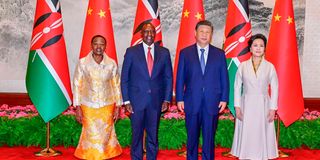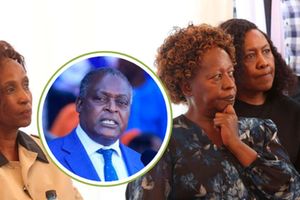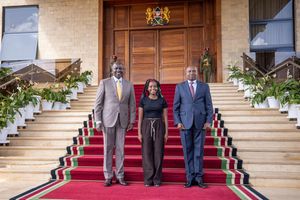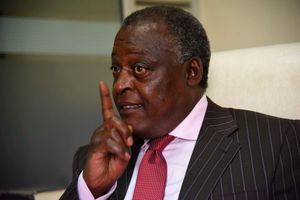Premium
Kenya 'agrees' to multi-way funding model for SGR extension to Malaba

President William Ruto with his Chinese counterpart Xi Jinping at the Great Hall of the People in Beijing, China.
What you need to know:
- The model involves part funding from Kenyan government up to 30 percent, a commercial venture collaboration between Chinese infrastructure lenders and Kenyan banks to the tune of 40 percent and a top-up of 30 percent from the Chinese government
- It also involves exclusive Chinese contracting to build and operate the line to help recoup the money spent for at least 25 years after completion
Kenya on Thursday appeared to agree to China’s preconditions to fund a railway line extension to the border with Uganda, securing one of the most critical ambitions under the administration of President William Ruto.
The details emerged after President Ruto met with Chinese counterpart Xi Jinping in Beijing for bilateral talks as part of the Kenyan leader’s State Visit to China this week.
The deal itself and its fine print was omitted from official dispatches shared with the media after the meetings. But The Nation understands the Chinese agreed to build the extension of the railway line from Naivasha on to Malaba, under a three-way funding model.
Officially, the two sides agreed on an MoU to review railway sector laws, regulations and policies as well “as the development of railway technical and operation standards.”
“The MOU also seeks to guide the planning and subsequent advancement and development of railway infrastructure to cover locomotives, rolling stock and railway operational management as part of the multimodal transport,” an official dispatch said.
Sources indicated that Kenya has had to agree on a tougher funding model this time as it seeks at least $4.5 billion to complete the line from Naivasha to Malaba and raise the viability of the project.

President William Ruto, First Lady Rachel Ruto, China President Xi Jinping with his wife Peng Liyuan pose for a photo at the Great Hall of the People in Beijing, China.
The model involves part funding from Kenyan government up to 30 percent, a commercial venture collaboration between Chinese infrastructure lenders and Kenyan banks to the tune of 40 percent and a top-up of 30 percent from the Chinese government. It also involves exclusive Chinese contracting to build and operate the line to help recoup the money spent for at least 25 years after completion.
That arrangement means Kenya will have to review its laws on the railway development levy and land ownership to make it part of the funding security because a special purpose vehicle to be created will possess the assets during the construction and operation of the final line until the financiers recoup the money.
In a way, the funding has been framed as part Public Private Partnership (PPP) and part concessional lending to be secured by collected levies. The government is seeking to prevent Kenya from accruing more debt, but as long as the final line actually earns its money from operations to repay the loan. Either that or the government will forgo the railway levy revenues and own the project debt, an undesirable possibility.
Kenya had eyed the railway levy before to plug funding gaps in its budget. Last year, it earned some $245 million, although that was below the targeted $270 million. Then in December 2024, Kenya amended a law on the Railway Development Levy, increasing the rate from 1.5 percent to 2 percent. The new RDL is applicable to all goods imported for domestic use, although the levy was first was first introduced in 2013, intended, originally, to finance building the new railway from Mombasa to Kisumu.
The levy operates on assumption that imports would continue to rise and hence more revenue it to be collected. A joint statement from the meetings in Beijing said Kenya and China will pursue an “integrated development of infrastructure and industries” including the main railwayline, promote China-Africa industrial circles and “work together to build a China-Africa network featuring land-sea links and coordinated development.
It did not mention the Naivasha-Malaba SGR line by name but it said the two sides will “institutionalise cooperation between their railway authorities, deepen exchanges and cooperation in the railway sector and promote infrastructure connectivity.”
Long-running headache
For Kenya, the Standard Gauge Railway extension to Malaba has been a long-running headache because it is something it needed to do to make the line viable, but has been constrained by mounting debt, largely from the first two phases of the line from Mombasa to Naivasha which were incidentally financed by China and cost some $6 billion
Ahead of the visit, Dr Korir Sing’oei, the Foreign Affairs Principal Secretary told the media on Monday that Kenya is in great need of financing to complete stalled projects, or extend those which can’t make enough money at the money. But he said Nairobi is being realistic on its debt situation.
“The key issue has to do with Kenya’s fiscal capacity to take on board new facilities, given the fact that we have had challenges with regards to interest rates from some of the debts and the volatility that has increased the debt,” he said at a press briefing in Beijing on Monday.
“What we need to do is to agree on a funding model. Because Kenya holds the view that if this railway were to reach Malaba, it would generate enough revenue which would enable it pay for itself more,” he added, referring to the Standard Gauge Railway.
“We are trying to persuade our colleagues in China to consider the possibility of a different financial model that is outside the loan arrangement. That conversation has progressed a great deal and we are looking at our counterparts at different models.”
Dr Sing’oei said Kenya has already endorsed the Public Private Partnership arrangement or “look into ways into which some of the instruments of financing our railway infrastructure like the railway financial assets and securitising these assets to finance the next phase of development.”
Kenya’s two big ticket projects, extending the SGR to Malaba from Naivasha and widening the main highway from Nairobi to Nakuru and on to Malaba, had been on the table for the last one year.
And although the Chinese are amenable to taking on the PPP, they generally have wanted more convincing from Nairobi. They have asked Kenya to provide guarantees the line will make money or at least encourage businesses towards it. One way of doing that, according to some officials was to expand the port in Kisumu and encourage shipments towards it. A busier port on Lake Victoria, could drive more businesses over the line.
Meanwhile, the Chinese said they were ready to collaborate with Kenya on key issues of mutual concern, as well as back Kenya’s infrastructure development and open markets for “quality Kenyan goods.” But they demanded sincerity from the Kenyan side, and said engagements on these issues will depend on Kenya’s priorities.
Deals signed at the Great Hall of the People:
- Memorandum of Understanding on Cooperation in the Railway Sector where there will be a review of the Railway sector laws, regulations and Policies as well as the development of Railway technical and operation standards. The MOU also seeks to guide the planning and subsequent advancement and development of railway infrastructure to cover locomotives, rolling stock and railway operational management as part of the multimodal transport;
- Framework Agreement on Economic Partnership for shared Development which constitutes a collaboration on sustainable development of the manufacturing industry, agricultural transformation and improving Kenya’s competitiveness in the global market. The agreement will guide the facilitation of trade, inclusive growth, coordination of supply chain and the digital economy.
- Memorandum of Understanding on Blue Economy, Fisheries and Maritime Affairs Cooperation whose objective is to enhance cooperation in Blue Economy, Fisheries, and Marine Affairs;
- Memorandum of Understanding on Scientific and Technological Cooperation;
- Cooperation Plan on Jointly promoting the Belt and Road initiative where both countries are willing to strengthen practical cooperation in areas such as infrastructure, trade and investment, digital economy, finance, education and talent cultivation, cultural tourism and people-people-people exchanges.
- Protocol on Quarantine and Hygiene Requirements for Edible Aquatic Animals to be Exported from Kenya to China, meant to establish an effective food hygiene and safety management.
- Cooperation Agreement between Kenya Broadcasting Cooperation and Xinhua News Agency of the People’s Republic of China on News Exchange with the objective of enhancing exchange and cooperation in the field of news dissemination;
- Memorandum of Understanding in the Field of Capacity Development between the Kenya School of Government and National Administration Academy
- Memorandum of Understanding on Joint Implementation of the 2025 Human Resource Development Cooperation Plan.
- Memorandum of Understanding on Vocational Education Cooperation.
- Memorandum of Understanding on Electronic Commerce that will see the enhancement of information exchanges on e-commerce laws and regulations; strengthening mutual trust in cyberspace; joint research and trainings geared towards e-commerce cooperations;
- Memorandum of Understanding on Strengthening Digital Economy Cooperation.
- Memorandum of Understanding between Ministry of Information, Communication and the Digital Economy and the State Council Information Office and the China Media Group allowing for News Exchange.
- Framework Agreement of Cooperation in the field of Irrigation and Water Resources,





